
Click edit button to change this text. Lorem ipsum dolor sit amet, consectetur adipiscing elit. Ut elit tellus, luctus nec ullamcorper mattis, pulvinar dapibus leo.

Click edit button to change this text. Lorem ipsum dolor sit amet, consectetur adipiscing elit. Ut elit tellus, luctus nec ullamcorper mattis, pulvinar dapibus leo.

Click edit button to change this text. Lorem ipsum dolor sit amet, consectetur adipiscing elit. Ut elit tellus, luctus nec ullamcorper mattis, pulvinar dapibus leo.

Click edit button to change this text. Lorem ipsum dolor sit amet, consectetur adipiscing elit. Ut elit tellus, luctus nec ullamcorper mattis, pulvinar dapibus leo.
Melbourne is often described as Australia’s cultural capital, and one of the most unique aspects that defines the city is its vibrant laneway culture.
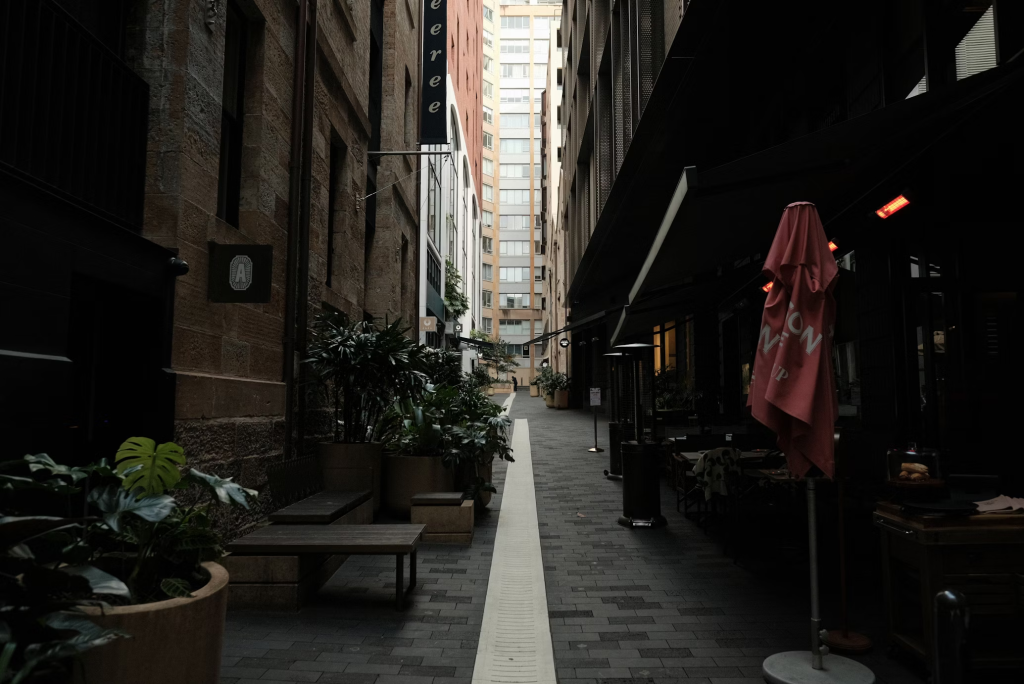
Nestled within these narrow passages, Melbourne’s laneways reveal hidden art, quirky cafes, independent boutiques, and historic sites, making them a key part of the city’s identity.
For locals and tourists alike, these laneways provide a glimpse into the city’s creative heart, a space where art, cuisine, and history intermingle in a way that feels distinctly Melbourne.
In this article, we’ll explore the essence of Melbourne’s laneway culture, why it’s so beloved, and how it contributes to the city’s reputation on the global stage.
Laneways have a special place in Melbourne’s urban fabric, characterized by their hidden charm, artistic spirit, and vibrant social scenes.
Originally used for deliveries and as service areas behind commercial buildings, these narrow streets have since evolved into cultural hubs.
The transformation of Melbourne’s laneways began in the 1980s when artists, musicians, and entrepreneurs started repurposing these spaces, filling them with street art, cafes, and boutiques that set the city apart.
Today, Melbourne’s laneways are known for their eclectic mix of art and commerce, often hidden in plain sight.
This sense of discovery is a core part of the laneway experience – a passerby might stumble upon a mural by a famous street artist, a pop-up food stall, or a cozy coffee shop tucked between historic brick walls.
Hosier Lane, for example, is famous for its ever-changing street art, drawing artists from around the world to showcase their work.
Other laneways, like Degraves Street, are bustling with coffee shops, bakeries, and boutiques that capture the essence of Melbourne’s renowned café culture.
In essence, Melbourne’s laneway culture is about embracing creativity, fostering community, and celebrating the unexpected.
For many, exploring these hidden passages offers a break from the commercialized and structured parts of the city, providing a space where creativity and authenticity shine.
If you’re visiting Melbourne, there are several iconic laneways that you simply can’t miss. Each one offers a unique experience, from world-class street art to bustling cafes and unique shops.
Here are some of the most famous laneways that showcase the best laneways in melbourne culture:
These are just a few examples, but Melbourne has over 200 laneways to explore, each offering a unique piece of the city’s character.
Whether it’s art, music, food, or shopping, the laneways provide something for everyone, making them a must-visit for anyone wanting to experience Melbourne’s true spirit.
The laneway culture in Melbourne does more than provide a backdrop for tourism; it’s an integral part of the city’s cultural identity.
The laneways have become an open stage where artists, entrepreneurs, and creators can express themselves freely.
This culture of expression and innovation has helped position Melbourne as a global city of arts and culture, attracting both creative talent and tourists who seek a unique urban experience.
One of the most significant ways laneways shape Melbourne’s identity is through street art. Street art in Melbourne is not only tolerated but celebrated, with city policies supporting artists who contribute to the laneway scenes.
The art seen in places like Hosier Lane is dynamic and fluid, constantly evolving with new layers of paint, ideas, and social commentary.
This openness has led Melbourne to become an internationally recognized city for street art, with artists from around the world coming to leave their mark.
The café culture within these laneways also adds to Melbourne’s reputation as a foodie destination. Small cafes and eateries that line the laneways offer diverse culinary experiences, from Italian and French patisseries to specialty coffee and fusion foods.
These establishments often favour quality and creativity over-commercialisation, fostering an intimate dining experience that feels like a discovery each time.
Moreover, Melbourne’s laneway culture reflects a blend of historical preservation and modern creativity.
Many of the buildings within these laneways have been around since the city’s early days, giving them a nostalgic charm.
Repurposing these older spaces into modern cafes, bars, and art spaces reflects Melbourne’s ability to retain its historical roots while adapting to contemporary trends.
This blend of old and new allows residents and visitors to experience both Melbourne’s past and present, creating a sense of continuity and belonging within the urban landscape.
Melbourne’s laneway culture is more than just a collection of hidden streets; it’s a living, breathing expression of the city’s soul.
In a world where urban spaces are often defined by skyscrapers and chain stores, Melbourne’s laneways stand as a refreshing reminder of the power of creativity, community, and individuality.
Each laneway tells its own story, reflecting the diversity of Melbourne’s people and the city’s openness to new ideas.
The charm of Melbourne’s laneways lies not only in what they offer but also in the sense of discovery they inspire.
Exploring these laneways is like peeling back the layers of the city to reveal an underground world brimming with art, music, food, and history.
They create a shared space where locals and visitors alike can pause, engage, and become part of the city’s ongoing narrative.
As Melbourne evolves, its laneway culture continues to grow and adapt, embracing new artists, innovative eateries, and cultural experiences while honouring the city’s storied past.
This dynamic environment makes Melbourne’s laneways a must-see destination that leaves a lasting impression.
For anyone visiting the city, the laneways are more than just a tourist attraction—they’re a chance to feel the beating heart of Melbourne, experience its vibrant creativity, and connect with a culture that celebrates uniqueness, innovation, and community.
In every twist, turn, and mural, Melbourne’s laneways invite us to explore a city that thrives on artistic freedom and the joy of discovery.
Melbourne shines during Christmas, offering a unique blend of traditional festivities with its cosmopolitan flair. From iconic light displays to pop-up markets and cozy family-friendly events, the city presents a festive atmosphere that captivates visitors and locals alike.
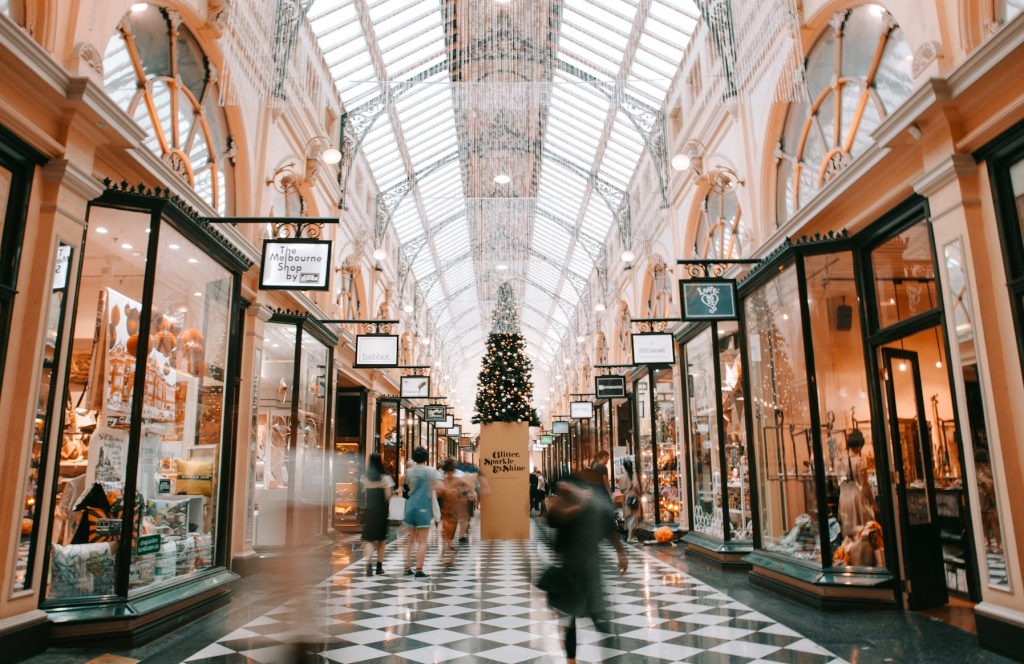
Whether you’re here to witness the glittering Christmas decorations in the CBD or prefer exploring seasonal markets and outdoor events, Melbourne ensures there’s something for everyone.
Let’s take a closer look at some of the top places to visit in Melbourne during the holiday season and how you can make the most of Christmas in this beautiful city.
Melbourne is well-known for its dazzling Christmas lights, with different suburbs and landmarks going all out to showcase their decorations.
Here are some key places you can visit to enjoy the best displays and things to do christmas day melbourne:
The heart of Melbourne is where the magic truly happens during Christmas, with Federation Square becoming the hub of festive cheer. You’ll find giant, beautifully decorated Christmas trees, interactive light displays, and regular performances that create a lively holiday vibe.
Walk over to Bourke Street Mall and Collins Street, which are both adorned with decorations, offering a perfect background for your Christmas photos.
Federation Square also hosts a massive digital Christmas tree, illuminated nightly and surrounded by various Christmas-themed stalls and activities.
Be sure to catch the light shows in the evening, as they bring a mesmerizing display that is fun for families, couples, and friends alike.
Nearby, the State Library Victoria and Melbourne Town Hall are also illuminated with holiday projections, making the city centre a top spot for festive light displays.
A classic Melbourne tradition, the Myer Christmas Windows on Bourke Street have been a family favourite for over 60 years.
Each year, the windows feature a new theme inspired by a children’s story, with intricate, animated displays that bring the narrative to life.
Kids and adults alike find the experience enchanting, and the creative, artistic displays have a magical quality that keeps everyone returning year after year.
Since it’s a free activity, it tends to attract large crowds, especially closer to Christmas. Visiting early in the season or during quieter weekday hours is often a good idea to avoid the hustle and bustle.
If you’re visiting with young children, keep an eye out for Myer’s Santaland Express, a mini-train inside the store that leads to Santa’s grotto, where kids can meet Santa himself.
Melbourne’s Christmas markets offer a variety of unique gifts, handmade crafts, and seasonal treats that make shopping for friends and family a memorable experience.
The festive atmosphere, combined with live music, street food, and pop-up stalls, brings out the best of Melbourne’s artisanal culture.
One of the city’s most popular Christmas markets is held at Queen Victoria Market, which is transformed into a winter wonderland.
Here, visitors can enjoy everything from Christmas carolers to unique gifts and holiday decor.
The market’s food section is particularly popular, offering festive treats like gingerbread cookies, mulled wine, and Christmas puddings, alongside the usual fresh produce.
Queen Victoria Market also hosts a night market during the holiday season.
This is a wonderful way to enjoy Christmas shopping under the stars, with a variety of food trucks, craft stalls, and live entertainment to add to the festive atmosphere.
It’s also an excellent place to buy last-minute gifts and indulge in seasonal eats that showcase flavours from around the world.
For those looking for locally crafted gifts and artwork, the Arts Centre Melbourne Christmas Market is a great choice.
Located at the Southbank promenade, this market specializes in handmade jewellery, homewares, and artisan crafts created by local artists.
It’s an ideal spot for finding one-of-a-kind items, with the scenic backdrop of the Yarra River adding to the experience.
The Southbank area is also known for its culinary variety, so after exploring the market, you can stop by one of the many nearby restaurants for a festive meal.
If you’re looking for unique decorations or sustainable, eco-friendly gifts, this market is especially popular among locals who enjoy supporting Melbourne’s artisan community.
Melbourne’s Christmas season is packed with family-friendly activities, from holiday performances to interactive displays that captivate kids and adults alike.
Santa’s Magical Kingdom is an annual event that combines Christmas cheer with the wonder of a circus.
Held at Caulfield Racecourse, this magical experience brings the North Pole to Melbourne, complete with Mrs Claus’ kitchen, an interactive snow land, and circus performances that include acrobats, jugglers, and a special Christmas-themed show.
Kids can meet Santa and have their photos taken, while parents can enjoy holiday-themed refreshments and browse through festive stalls.
With plenty of rides and Christmas-themed attractions, Santa’s Magical Kingdom has something for every family member. It’s highly popular, so booking tickets in advance is recommended to avoid disappointment.
Federation Square doesn’t only shine with lights—it’s also a gathering spot for family-friendly holiday events.
The square transforms into Christmas Square, with a giant Christmas tree, Santa’s House, and a range of free activities for kids. Families can visit Santa’s House to take photos and interact with the friendly elves.
There are also story-time sessions, arts and crafts, and a variety of seasonal workshops, all of which create a welcoming space for kids and parents alike.
The atmosphere here is particularly festive in the evenings, with carolers and musicians adding to the Christmas spirit.
Federation Square’s location makes it easy to combine this visit with other nearby attractions, like the Myer Christmas window or a stroll along the decorated streets.
Carols by Candlelight is a Melbourne Christmas tradition that brings together locals and visitors to celebrate the holiday season with song.
Held at the Sidney Myer Music Bowl, this annual event features performances by local and international artists singing holiday classics.
The atmosphere is warm and family-friendly, with thousands of people gathering to enjoy a candlelit evening under the stars.
The event is also televised, making it accessible to those who prefer watching from home.
However, attending in person offers a unique and heartwarming experience, as you sing along to carols surrounded by fellow holiday enthusiasts.
Proceeds from the event go to Vision Australia, adding a charitable element to the festive celebration.
Melbourne is a wonderful city to experience the magic of Christmas. With its vibrant light displays, festive markets, and family-friendly events, the city offers a wide array of activities that capture the spirit of the season.
From the dazzling lights at Federation Square to the enchanting Myer Christmas Windows and the bustling Queen Victoria Christmas Market, Melbourne creates a magical holiday experience that appeals to all ages.
Whether you’re visiting with family, exploring with friends, or enjoying a romantic outing, Melbourne’s Christmas events and attractions provide countless ways to celebrate.
So, put on your Christmas sweater, grab a cup of mulled wine, and head out to experience the festive cheer that fills Melbourne’s streets and squares each December.
With so many unique places to go and traditions to participate in, celebrating Christmas in Melbourne is sure to be an unforgettable experience.
Sydney, Australia’s sparkling city by the sea, has an international reputation for stunning views, rich culture, and its world-famous Sydney Opera House and Harbour Bridge.

But for those considering moving to this coastal metropolis or current residents weighing their budgets, one question often comes to mind: Is it expensive to live in Sydney?
With Sydney consistently ranking as one of the world’s priciest cities, it’s worth exploring what exactly makes living here costly and how locals balance lifestyle with the cost of living.
In this guide, we’ll break down major expenses in Sydney, discuss how costs compare to other cities, and offer some tips to save in this vibrant but high-cost city.
When thinking about the cost of living in Sydney, one word comes to mind for many people: expensive. But what does that mean in practical terms? So, how much does it cost to live in sydney? Let’s examine the main contributors to the high cost of living in this city.
Housing is, by far, the biggest contributor to Sydney’s high cost of living. With limited space and high demand for city proximity, both renting and buying property can be a major strain on one’s finances.
In 2024, average rental prices for a one-bedroom apartment in the city centre hover around AUD 3,000 per month, while apartments further from the city centre can go for around AUD 2,100 monthly.
A similar comparison in Melbourne, for instance, shows that housing there is about 20-30% cheaper.
Buying a home in Sydney is even more challenging. The median house price in the city is about AUD 1.5 million, and the median price for units sits at around AUD 800,000, according to recent data.
Compared to other parts of Australia, these numbers are quite high, and many residents need to save for years or rely on dual incomes to even enter the property market.
Interest rates and taxes further increase the financial burden, making owning a home a big commitment in Sydney.
Sydney boasts an extensive public transport network, but it doesn’t come cheap. A single one-way ticket can cost around AUD 4.50 for a short trip and up to AUD 9.60 for longer journeys.
Those who rely on public transport frequently might spend between AUD 50 to AUD 70 weekly.
Compared to other major cities, this is relatively high, but the Opal card system helps residents save a bit by capping travel expenses each week.
Car owners face their own set of costs, as fuel prices, parking fees, and tolls can add up. Parking in central Sydney can cost upwards of AUD 30 an hour, and toll roads are common in and around the city.
A monthly fuel expense can easily reach AUD 150, while insurance and regular maintenance also demand a steady stream of income.
However, the recent expansion of bike lanes has encouraged some to opt for cycling, which, while still a small minority, offers a cost-effective alternative.
Groceries and dining costs are another key factor impacting Sydney’s living expenses. A basic grocery bill for a single person can cost between AUD 80 to AUD 120 per week, depending on preferences and brands.
For a family, this can go up to around AUD 300 weekly. Fresh produce and meats are particularly pricey, though local farmer’s markets and discount supermarkets like Aldi provide some relief.
Comparatively, grocery costs in Sydney are higher than in many Australian cities but are similar to global prices in high-cost urban areas.
Dining out in Sydney offers a wonderful mix of international cuisines and fusion options but comes with a steep price tag.
A meal at a mid-range restaurant could cost around AUD 25 to AUD 45 per person, with drinks and tips further adding to the expense.
Sydney’s vibrant café scene means brunches and coffees are popular, with an average coffee costing around AUD 4.50 to AUD 5.50.
Sydney may be expensive, but how does it measure up to other well-known global cities?
When compared with cities like New York, London, and Tokyo, Sydney holds its ground as one of the pricier cities in the world, though it offers a unique quality of life that attracts people from all corners of the globe.
Compared to New York City, for instance, rent in Sydney is slightly lower, though groceries, dining, and transportation costs can be similar. Living in central areas of both cities presents a significant financial challenge.
In terms of housing affordability, London is closer to Sydney, with both cities grappling with high real estate costs and rent-to-income ratios that make saving a challenge for renters.
Meanwhile, Tokyo offers more affordable rents, but groceries and transportation costs are similar to Sydney’s.
Tokyo has a reputation for quality and efficiency at a lower cost, especially in areas such as dining out and public transportation.
This can make Tokyo an appealing alternative for those looking for a major city experience without the full financial burden that Sydney demands.
Within Australia, Sydney stands at the top of the cost scale. Melbourne, while also expensive, generally offers slightly lower housing costs, along with cheaper utilities and public transportation fees.
Brisbane and Adelaide, both popular cities with growing populations, have noticeably lower costs across most categories, making them appealing alternatives for people looking to stay within Australia without the high expense of Sydney.
However, for many, the unique blend of culture, job opportunities, and scenic beauty make Sydney worth the extra cost.
Despite Sydney’s high expenses, many residents find ways to keep living costs manageable. Here are a few practical strategies for saving while living in this world-renowned city.
Living in Sydney is undoubtedly a financial commitment, with high costs across housing, transport, and daily living. However, for those who call this beautiful city home, the expense is often outweighed by the quality of life that Sydney offers.
Its cultural vibrancy, natural beauty, and thriving job market attract people from all around the world, and for many, the lifestyle and experiences available in Sydney make the cost worth it.
While careful budgeting and smart choices can help manage expenses, it’s Sydney’s unique allure that often convinces people to stay.
Sydney, with its iconic landmarks, pristine beaches, and dynamic city life, is a playground for families looking to spend quality time together.
For parents, finding engaging activities that cater to kids of all ages can be a game-changer, making family outings both memorable and manageable.

Whether your kids are budding scientists, animal lovers, or thrill-seekers, Sydney offers an array of destinations to ensure everyone has an amazing time.
Here, we’ll explore some of the best spots to take your kids out in Sydney, along with tips to make the most of these excursions.
Sydney is brimming with family-friendly destinations where kids can explore, learn, and burn off some energy. Below are some popular options where you can take the kids for an exciting day out.
While Sydney’s man-made attractions are impressive, the city’s natural beauty offers endless opportunities for outdoor adventures. Kids benefit from fresh air, exercise, and a chance to connect with nature, all of which are abundant in Sydney.
Sydney’s unpredictable weather sometimes calls for an indoor escape. When the rain hits, these indoor attractions provide endless fun and excitement for kids without sacrificing entertainment value.
Sydney’s vibrant mix of attractions truly makes it a paradise for families. The city’s diverse range of activities caters to children of all interests, from curious minds and animal lovers to budding adventurers and future scientists.
Beyond the fun, these outings provide rich opportunities for kids to learn, explore, and grow in a world-class setting.
Whether it’s gazing at giraffes at Taronga Zoo, discovering prehistoric wonders at the Australian Museum, or enjoying an afternoon picnic at the Botanic Garden, each experience adds to the adventure of growing up.
Sydney’s unique blend of natural beauty and urban excitement creates a balance that few other cities offer, making it an ideal playground for families to bond, create lasting memories, and simply enjoy each other’s company.
And with options for every season, Sydney’s family-friendly appeal is truly year-round. Even on rainy days, places like the SEA LIFE Aquarium and the Powerhouse Museum promise that the fun never has to stop.
From the thrill of amusement parks to the tranquillity of national parks, Sydney’s attractions bring families closer together, creating those special moments that kids and parents alike will treasure long after the day is over.
So next time you’re planning a family day out, dive into the endless options Sydney has to offer and make the most of this beautiful city’s welcoming family spirit.
For more information, read his guide “sydney attractions for families”.
Moving to Sydney is an exciting adventure filled with opportunity, stunning scenery, and diverse neighbourhoods to explore. However, relocating to a new city can feel overwhelming without the right preparation and insights.

From understanding the housing market to adapting to Sydney’s lifestyle and planning a sustainable budget, having a guide can make your move smoother and more enjoyable.
Here’s what you need to know about moving to Sydney, including essential tips on housing, transportation, lifestyle, and much more.
Sydney is Australia’s largest and most iconic city, famous for its sparkling harbour, world-class beaches, and vibrant cultural scene. For many, it’s a dream destination, but settling in Sydney comes with unique challenges and rewards. Here are some key considerations:
Sydney consistently ranks among the most expensive cities in the world, and housing costs often take up a significant portion of any newcomer’s budget.
The cost of living includes not only high rents but also higher grocery and service expenses compared to other Australian cities.
Average rental prices for apartments vary by location, with central areas like Sydney CBD, Surry Hills, and Bondi being pricier compared to suburbs like Parramatta or Bankstown.
When looking for a place to live, Sydney offers a range of housing options:
To find a rental property, you can use sites like Domain, Realestate.com.au, or specialized Facebook groups.
It’s important to have a good rental history and references, as the rental market can be competitive, especially in peak moving seasons (usually late summer and early autumn).
Sydney’s public transport system includes trains, buses, ferries, and a light rail network, making it relatively easy to get around without a car.
However, the city’s vast size and some transportation limitations mean that commute times can vary widely depending on where you live and work.
If you do prefer to drive, it’s worth noting that Sydney has a reputation for heavy traffic, particularly during rush hours. Parking in the city centre can also be expensive and limited.
Many newcomers decide to forego a car initially, especially if they live close to work or a major transportation line.
Sydney is known for its laid-back, outdoor-oriented lifestyle. With a pleasant climate most of the year, locals love to spend time at the beach, enjoy outdoor dining, and engage in sports and fitness activities.
Understanding Sydney’s lifestyle and culture can help you settle in more comfortably and feel at home faster.
It’s also important to understand Sydney’s pace, which is a mix of high-energy city life with a relaxed, beachside vibe.
Embracing this balance will make it easier to integrate into Sydney’s way of life, whether you’re exploring the city’s cafes, catching an ocean breeze, or attending cultural events.
Adjusting to Sydney’s high cost of living can be one of the biggest challenges, but with careful planning, you can make the most of your income and manage expenses effectively. Here are some budgeting tips specific to Sydney:
Saving money might also mean choosing off-peak times for moving and exploring less crowded areas that are equally beautiful.
For example, while Bondi Beach is world-famous, Sydney’s Northern Beaches and smaller bays offer excellent experiences with fewer crowds and lower associated costs.
One of the best ways to adjust to a new city is to connect with others. Sydney’s diverse population and expat-friendly atmosphere make it easy to find new friends, build networks, and feel at home.
By building connections, you’ll gain insights from others who’ve been through similar experiences, while also creating a social network that will enrich your new life in Sydney.
Moving to Sydney is a big step, but with the right preparation, you can make the transition seamless and start enjoying all that this beautiful city has to offer.
From understanding the housing market and adjusting to the high cost of living to making the most of Sydney’s vibrant culture, your relocation can become an enriching and enjoyable experience.
Sydney is a city that invites newcomers to explore, learn, and grow, offering a dynamic blend of lifestyle, opportunity, and natural beauty.
With patience, an open mind, and a bit of planning, your move to Sydney will not only open doors to new adventures but also set the stage for a fulfilling new chapter in Australia’s iconic harbour city.
Click the dimmi sydney cbd, to know more information.
Sydney is world-renowned for its vibrant culture, scenic harbours, and incredible nightlife. With a blend of glitzy bars, intimate live music venues, and pulsating clubs, it’s a city that truly comes alive after dark.
Whether you’re a local looking to discover new night-time experiences or a visitor ready to explore, Sydney offers areas that cater to every style and preference.

In this article, we’ll break down the best areas in Sydney for nightlife, focusing on the unique vibe each one offers. From the iconic to the underrated, let’s dive into the best places to experience Sydney at night.
When it comes to Sydney nightlife, Darlinghurst stands out as one of the most exciting neighbourhoods. Known for its eclectic mix of bars, live music venues, and quirky nightlife spots, Darlinghurst draws a crowd that loves the diversity and energy it provides.
Nestled just outside of the Central Business District (CBD), Darlinghurst has become a go-to destination for both locals and tourists looking for something different.
One of the defining aspects of Darlinghurst is its welcoming and inclusive atmosphere. This area has long been known for its strong ties to Sydney’s LGBTQ+ community, making it a hub for events, gatherings, and parties where all feel welcome.
The famous Oxford Street, Darlinghurst’s main artery, is lined with legendary spots like the Oxford Hotel and the Colombian Hotel, both offering lively atmospheres and packed dance floors well into the early morning hours.
If you’re more into relaxed lounges, Darlinghurst also has plenty to offer. Trendy cocktail bars like Shady Pines Saloon and Eau de Vie are perfect for an intimate experience or a special night out.
The ambience here ranges from rustic and laid-back to sophisticated and swanky, allowing you to switch up your night as you see fit.
Another defining feature of Darlinghurst is the incredible food scene that complements the nightlife. A night out in Darlinghurst is rarely complete without a meal at one of the many multicultural eateries dotted around the area.
From late-night ramen at Chaco Bar to Mediterranean fare at Bar Nina, there’s always something delicious to keep your energy up between dancing or bar-hopping sessions.
For those in search of a more sophisticated nightlife experience, Potts Point is a fantastic choice. This charming, stylish neighbourhood has a reputation for elegant cocktail bars, chic restaurants, and unique late-night spots.
While Potts Point may not offer the all-night energy of Darlinghurst, it has a relaxed, refined atmosphere that makes it ideal for a more intimate night out.
One of the highlights of Potts Point is its incredible selection of small bars and lounges.
Establishments like The Butler, which offers a beautiful rooftop view, and the intimate, dimly-lit Dulcie’s Kings Cross, provide luxurious settings perfect for date nights or gatherings with close friends.
For wine lovers, Monopole is an award-winning wine bar that has a reputation for both its impressive wine list and contemporary ambience.
But Potts Point isn’t just for wine and cocktails; it’s also known for a thriving dining scene that can easily be paired with a night out.
Highly acclaimed restaurants like The Apollo and Fratelli Paradiso provide a luxurious start to any evening, whether you’re in the mood for Greek mezze or Italian specialties.
After dinner, the numerous low-key bars and lounges scattered across Potts Point offer a classy and enjoyable way to unwind.
For a dose of history with your nightlife, Potts Point sits close to Kings Cross, Sydney’s former red-light district.
While the Kings Cross area has transformed significantly, it still has a unique character, with a few hidden gems like The Roosevelt, a vintage-inspired cocktail bar that channels old-school glamour.
Potts Point offers an ideal blend of sophistication and a nod to the old nightlife traditions of Sydney, creating a unique night-time vibe that’s both polished and full of character.
If you’re looking for something more offbeat and artistic, Newtown is an excellent area to explore. Known for its thriving arts scene and alternative culture, Newtown provides a nightlife experience that’s vibrant, unpretentious, and filled with character.
Unlike Darlinghurst or Potts Point, which cater more to the traditional nightlife crowds, Newtown has a laid-back, eclectic vibe that’s ideal for lovers of live music, craft beer, and quirky bars.
One of the biggest draws of Newtown is its live music venues, with the Enmore Theatre leading the way.
This historic venue hosts both local bands and international artists, drawing crowds who are passionate about music and keen to discover new sounds.
Smaller live music venues, such as The Vanguard and The Union Hotel, provide a more intimate setting where you can experience everything from jazz and rock to indie and folk performances.
Aside from music, Newtown’s bar scene is also worth exploring. Known for its numerous craft breweries and micro-distilleries, Newtown has several unique spots for fans of artisanal drinks.
Young Henrys, a well-loved local brewery, is a top choice for tasting local craft beers in a relaxed, hip setting.
For something a bit quirkier, The Midnight Special is a hidden gem that offers inventive cocktails in a rock ’n’ roll-inspired space.
There are also numerous retro bars, themed spots, and vegan-friendly establishments, catering to Newtown’s diverse, inclusive crowd.
In addition to drinks and music, Newtown’s multicultural dining scene is a huge part of its charm. From Turkish mezes at Cairo Takeaway to authentic Vietnamese at Thanh Binh, Newtown’s eateries add a delicious flavor to the area’s vibrant atmosphere.
It’s easy to bar-hop and sample different foods, with everything conveniently located within walking distance. For night owls who enjoy mingling in a crowd of students, artists, and musicians, Newtown offers a refreshing, alternative approach to Sydney nightlife.
Sydney’s nightlife is as diverse as the city itself, offering experiences that range from glamorous nights in Potts Point to the inclusive energy of Darlinghurst and the eclectic, music-filled scene in Newtown.
Each area has its unique character, making Sydney a playground for those who love to explore different atmospheres and styles in a single night.
Whether you’re after sophisticated cocktails, live music, or a lively dance floor, Sydney has a neighbourhood that caters to every mood and interest.
For the best nightlife experience, it’s worth trying each area at least once. Darlinghurst is perfect for those who enjoy energetic, inclusive spaces with plenty of dance options, while Potts Point offers a more refined, relaxed setting ideal for special occasions.
Newtown, on the other hand, is a must-visit for anyone interested in live music and quirky bars with an artsy twist.
Ultimately, Sydney’s nightlife landscape encourages exploration.
The variety available makes it easy to create memorable nights tailored to your personal preferences, so dive in, experience these different vibes, and find out what makes Sydney’s nightlife one of the best in the world.
Whether you’re a fan of jazz, craft beer, techno beats, or just a great cocktail, Sydney offers something for everyone after the sun goes down.
Are you in search of more information? Click and visit the coburg night market 2016, today!
The Melbourne Zoo, one of Australia’s oldest and most beloved zoological parks, stands as a must-visit destination for locals and tourists alike.
Located just minutes from the heart of the city, this vibrant zoo is home to over 320 species of animals, ranging from iconic Australian wildlife to exotic creatures from around the world.

Since its founding in 1862, Melbourne Zoo has captivated visitors with its commitment to conservation, education, and immersive animal experiences. But what exactly makes Melbourne Zoo so special?
Let’s take a closer look at the remarkable aspects of this institution and why it remains a premier destination for families, nature lovers, and adventurers alike.
Melbourne Zoo’s unique charm lies in its dedication to creating a naturalistic, enriching environment for its animals while promoting conservation and educating visitors.
Unlike traditional zoos, Melbourne Zoo has evolved to provide expansive enclosures designed to mimic the animals’ native habitats, allowing them to thrive in a setting that respects their natural behaviours.
Here are a few aspects that set Melbourne Zoo apart:
These qualities combined make Melbourne Zoo an unforgettable experience. By prioritizing both the visitor experience and the animals’ well-being, the zoo creates a dynamic environment that captivates guests of all ages.
Beyond its beautiful displays and well-designed habitats, Melbourne Zoo stands as a beacon of conservation and environmental activism.
The zoo is a proud participant in various conservation projects, both locally and globally, striving to protect vulnerable species and habitats. Some of the zoo’s notable initiatives include:
The Melbourne Zoo’s efforts reflect a broader vision of creating a sustainable future for wildlife.
By involving the public in conservation efforts and making education a core component of the zoo’s mission, it empowers individuals to contribute to wildlife protection.
This dedication to global and local conservation efforts cements Melbourne Zoo’s place as a leader in animal care and environmental advocacy.
Melbourne Zoo boasts a wide array of exhibits and experiences that cater to various interests, from playful family attractions to serene, immersive environments. Here are some of the zoo’s most popular areas:
These exhibits, combined with the opportunity to interact with knowledgeable staff, make a visit to Melbourne Zoo both educational and engaging.
The zoo’s carefully curated spaces and dedicated staff ensure every visitor leaves with a greater appreciation for wildlife and the importance of conservation.
Melbourne Zoo is far more than a place to observe animals; it’s a living testament to the power of conservation, education, and community engagement.
As Australia’s oldest zoo, it has continuously adapted to modern standards of animal welfare and sustainable practices, becoming a model for zoos worldwide.
From its immersive habitats and conservation efforts to its interactive visitor experiences, Melbourne Zoo provides a meaningful, enjoyable experience for all who enter its gates.
The zoo’s commitment to protecting wildlife, raising awareness, and inspiring future generations is evident in every corner of the park.
Whether you’re feeding a giraffe, walking through a kangaroo enclosure, or learning about endangered species, each interaction leaves a lasting impression and encourages respect for the natural world.
A visit to Melbourne Zoo offers the chance not only to encounter amazing animals up close but also to contribute to the conservation of these magnificent creatures.
With its family-friendly atmosphere, educational programs, and unparalleled dedication to wildlife, Melbourne Zoo continues to be a cherished destination for anyone looking to experience the wonders of the animal kingdom while supporting vital conservation efforts.
For more information, click and read this guide where is melbourne zoo.
When it comes to Melbourne, each suburb has its unique charm, and the northern suburbs are no exception. These areas are known for their vibrant community, rich culture, and a blend of historic and modern living.

The northern suburbs of Melbourne appeal to residents and visitors alike, offering a mix of urban amenities, green spaces, and an abundance of trendy spots that cater to diverse lifestyles.
In this article, we’ll explore what areas are considered northern suburbs, dive into what makes these neighbourhoods stand out, and examine what attracts so many people to this part of Melbourne.
Melbourne’s northern suburbs begin just a few kilometres north of the Central Business District (CBD) and extend outwards, covering areas that showcase both inner-city vibrancy and suburban calm.
While there’s no strict boundary for where Melbourne’s “northern suburbs” officially start and end, some well-known suburbs generally fall into this category. These include:
These suburbs highlight the diversity found in Melbourne’s northern side, each offering distinct lifestyles, housing options, and local cultures.
The northern suburbs have gained a reputation as some of Melbourne’s trendiest and most vibrant neighbourhoods. Here are a few key characteristics that set them apart:
One of the northern suburbs’ defining features is the immense cultural diversity present across the area.
Brunswick, Preston, and Coburg are well-known for their multicultural communities, with influences from Italy, Greece, the Middle East, and Southeast Asia, creating a rich tapestry of food, language, and traditions.
This cultural mix is evident in the variety of eateries, markets, and festivals that draw people from all over Melbourne to the northern suburbs.
The diversity is also reflected in the vibrant street art and cultural festivals that take place throughout the year.
Sydney Road in Brunswick, for example, hosts events like the Brunswick Music Festival and Sydney Road Street Party, which celebrate the local music and arts scenes.
This multicultural blend makes the northern suburbs an exciting place to explore and offers a welcoming atmosphere for new residents and visitors alike.
Melbourne’s northern suburbs are famous for their food and nightlife, especially in areas like Brunswick, Carlton, and North Melbourne.
These suburbs host an array of cafes, restaurants, and bars that cater to all tastes.
From Italian restaurants along Lygon Street in Carlton to Middle Eastern eateries in Coburg and trendy vegan spots in Fitzroy North, there’s no shortage of delicious and diverse food options.
Brunswick’s Sydney Road is especially known for its eclectic mix of food from around the world, with eateries offering Turkish kebabs, Lebanese mezze, Italian pizza, and Indian curries.
his diversity has earned Sydney Road the nickname “Eat Street” among locals and food enthusiasts.
In addition to the food, the northern suburbs have a lively nightlife scene. Boutique bars, live music venues, and vibrant pubs are scattered throughout the area.
Places like the Howler in Brunswick and the Northcote Social Club are popular for their live music events and energetic atmosphere.
Many venues also host open mic nights, comedy shows, and DJ sets, making the northern suburbs a hotspot for Melbourne’s young and creative crowd.
Compared to Melbourne’s inner-east suburbs, many areas in the north offer more affordable housing options, making it a popular choice for families, young professionals, and students.
Suburbs like Reservoir, Preston, and Fawkner provide more spacious housing and larger properties, which are appealing to those who want more space without moving too far from the city centre.
In contrast, areas like Brunswick and North Melbourne are more densely populated, with a mix of apartment buildings, Victorian terraces, and converted warehouses.
These suburbs are perfect for those who want an urban lifestyle with easy access to public transport, cafes, and entertainment options.
With its combination of affordability, accessibility, and vibrant lifestyle, the northern suburbs are a top choice for people moving to Melbourne.
The northern suburbs are packed with attractions that cater to various interests, from shopping and food markets to green spaces and art galleries. Here are some top spots you won’t want to miss:
Melbourne’s northern suburbs offer a unique blend of cultural diversity, affordability, and a thriving lifestyle scene, making them some of the city’s most desirable areas to live in or visit.
From the bustling streets of Brunswick and Carlton to the more relaxed, family-friendly neighbourhoods of Preston and Reservoir, each northern suburb has its character and appeal.
Whether you’re looking to explore multicultural food options, enjoy a night out at a live music venue, or settle into a quieter neighbourhood with plenty of green space, Melbourne’s northern suburbs provide a wide range of experiences and choices.
With their strong community spirit, diverse cultural influences, and growing popularity, these suburbs continue to attract people from all walks of life who seek to experience the unique northern side of Melbourne.
Are you looking for more information? Click and visit the best restaurants in melbourne northern suburbs, today!
Victoria, Australia, is renowned for its breathtaking landscapes, and summer is the perfect time to explore them. Camping is one of the best ways to experience the state’s diverse ecosystems—from stunning coastal beaches to lush forest hideaways and alpine regions.

Each spot offers a unique adventure, allowing you to reconnect with nature, disconnect from the routine, and enjoy quality time with friends and family.
In this guide, we’ll cover some of the top camping spots to enjoy Victoria’s beauty in summer, practical tips for the season, and essential gear to ensure a safe and enjoyable camping experience.
Victoria has a plethora of beautiful camping spots suitable for every kind of camper, whether you’re looking for a family-friendly spot or a rugged, off-the-grid experience. Here are some top choices:
Commonly referred to as “The Prom,” Wilson’s Promontory is one of Victoria’s most iconic camping destinations.
This national park, located at the southernmost tip of mainland Australia, offers a blend of pristine beaches, rugged mountain ranges, and lush rainforests.
Summer camping at Wilson’s Promontory means you can hike the coastal trails, swim in clear turquoise waters, and potentially spot native wildlife such as wombats, kangaroos, and even emus.
The Tidal River Campground is the main camping facility within the park, offering amenities such as toilets, showers, and even a general store. The summer months, however, are extremely popular here, so it’s wise to book early.
Activities like snorkelling at Norman Beach or hiking up Mount Oberon for panoramic views make Wilson’s Promontory a top camping spot in Victoria.
The Great Otway National Park combines lush forests, waterfalls, and coastal cliffs along the famous Great Ocean Road. This park offers a mix of camping options, from rainforest enclaves to beachside camping spots, each providing a distinctive experience.
Johanna Beach is one of the best camping spots within the park, and summer brings ideal weather for swimming, fishing, and surfing.
Blanketed in towering eucalyptus trees, Blanket Bay Campground is another fantastic spot for those who want to experience the natural beauty of the Otways.
The camping experience here is more rustic, with basic amenities, making it perfect for those seeking a back-to-basics adventure. Remember to book ahead in summer, as the Great Otway National Park is a popular holiday destination.
The Grampians is a stunning mountainous region offering everything from breathtaking views and challenging hikes to unique wildlife and ancient Aboriginal rock art.
For campers who love a bit of adventure and the chance to witness Victoria’s rugged natural beauty, this national park is a must-visit. Halls Gap, the main hub in the Grampians, has a large campground with excellent facilities, making it perfect for families and beginner campers.
Summer is an ideal time to hike up to the Pinnacle or Mackenzie Falls, as the trails are usually drier and offer a safer climb.
Additionally, rock climbing and abseiling are popular activities here, making it a great destination for adventure enthusiasts.
Just keep in mind that summer temperatures can be high, so staying hydrated and wearing sun protection is essential.
Having the right gear can make a big difference in your camping experience. Here’s a checklist of essentials to bring for a comfortable and enjoy the best camping spots victoria:
While summer is an ideal season for camping, the heat, wildlife, and potential for bushfires require extra precautions. Here are some safety tips to ensure you have a secure and enjoyable camping experience:
Camping in Victoria during summer is more than just a holiday; it’s an opportunity to reconnect with nature, experience breathtaking landscapes, and unwind under starlit skies.
Whether you’re venturing to the pristine beaches of Wilson’s Promontory, the lush rainforests of the Great Otway National Park, or the rugged terrain of the Grampians, each destination offers its unique charm and experiences.
Planning is key, especially during summer when these popular camping spots can book up quickly. Make sure you’re well-prepared by packing the right gear, staying informed about weather conditions and fire restrictions, and always keeping safety top of mind.
This will not only ensure a smoother camping experience but also help you make the most of Victoria’s natural beauty.
As you embrace outdoor living, take time to enjoy the simple pleasures that camping provides—unplugging from technology, immersing yourself in peaceful landscapes, and spending quality time with loved ones.
In these moments, you’ll find an appreciation for nature and a renewed sense of adventure.
Melbourne is a paradise for dog lovers, with a wide array of parks that cater to every type of dog and pet parent.
From sprawling open spaces to dedicated dog exercise zones and scenic, off-leash areas, Melbourne’s dog parks are designed with both the safety and enjoyment of pets in mind.

Whether you’re new to the city or a long-time resident, knowing the best spots to take your furry friend can add joy to your routine and allow your dog the freedom to socialize and explore.
This guide will dive into the best dog parks in Melbourne, tips for a successful outing with your pup, and the essential park etiquette to ensure everyone has a great experience.
Melbourne is brimming with a variety of dog parks, making it easy for pet owners to find convenient options throughout the city. These parks offer dogs the opportunity to run freely, play with other dogs, and enjoy the outdoors in a controlled environment.
Many of these parks also feature designated off-leash areas, where dogs can roam without restraint, as well as fenced sections for extra security. Here are some popular dog parks you and your furry friend can explore:
These parks are just a few examples of Melbourne’s fantastic dog-friendly spaces. Most parks in the city provide facilities such as water bowls, waste bags, and bins to help maintain a clean and safe environment.
However, as with all public spaces, it’s essential to adhere to park rules, particularly regarding leash requirements and waste disposal.
Taking your dog to the park can be an exciting experience, but preparation is key to ensure a positive time for both you and your pet. Here are some practical tips to keep in mind:
By following these tips, you can help make each visit enjoyable and stress-free for your dog. Positive experiences at the park can improve your dog’s social skills, contribute to their physical health, and strengthen your bond with them.
Most importantly, it creates an opportunity for them to interact with their environment in a way that’s enriching and fulfilling.
While dog parks are meant to be fun and relaxing, it’s important to respect the space and other park visitors to maintain a harmonious environment. Observing basic etiquette is a key part of being a responsible dog owner. Here are some essential etiquette practices for dog parks:
Dog parks are more than just a places for pets to run around; they’re social hubs where dogs can build friendships, practice social skills, and enjoy the outdoors.
For pet owners, Melbourne’s dog parks offer a chance to unwind and connect with other pet enthusiasts, making it a win-win experience.
From the iconic Albert Park to the scenic Yarra Bend trails, there’s a dog park in Melbourne to suit every personality, preference, and activity level.
So grab your leash, pack a bag of essentials, and set out to explore the city’s dog-friendly spaces.
You and your furry friend are bound to discover new favourite spots and make memories along the way, all while strengthening your bond and contributing to your dog’s well-being.
Are you in search of more information? The answer is here! Click and read his guide “best dog parks melbourne”. today!
Melbourne, often known for its cultural vibrancy, art scenes, and excellent coffee, may not immediately spring to mind when you think of diving hotspots.

However, beneath the waters off the coast of this bustling metropolis lies a treasure trove of underwater experiences that surprise even seasoned divers.
With its cool temperate waters and diverse marine life, Melbourne offers an intriguing alternative to the tropical diving spots typically associated with Australia, like the Great Barrier Reef.
In this article, we’ll explore whether there’s good diving in Melbourne, where you can dive, and what marine life you can expect to encounter.
The answer is a resounding yes. While Melbourne may not offer the warm waters and coral reefs found in tropical areas, it has a rich variety of dive sites that attract divers from all over the world.
The region is known for its unique underwater landscapes, shipwrecks, kelp forests, and an abundance of marine life.
Melbourne’s Port Phillip Bay and surrounding areas offer an exciting range of dive experiences, suitable for all levels. Whether you’re a beginner diver or an advanced technical diver, you’ll find sites that cater to your skill set and interests.
One of the key attractions for divers in Melbourne is the diverse marine environment. The bay is home to over 300 species of marine animals, many of which are endemic to the region.
One of Melbourne’s most famous dive sites is the HMAS Canberra, a decommissioned warship deliberately scuttled off the coast of Barwon Heads to form an artificial reef.
It lies in around 30 meters of water and is perfect for those who enjoy wreck diving. The ship is intact and offers the chance to explore the eerie corridors, rooms, and outer hull, where fish and invertebrates have taken up residence.
Advanced divers can venture deeper into the wreck, navigating the ship’s inner workings for a thrilling experience.
For those who prefer a more relaxed dive, the Rye Pier and Blairgowrie Marina in Port Phillip Bay are ideal. The piers provide a haven for photographers, thanks to the variety of smaller creatures such as seahorses, nudibranchs, and octopuses.
The structures of the piers are covered in colourful sponges, seaweed, and soft corals, making them visually stunning sites.
These piers are also perfect for night dives, where nocturnal species come out to feed, providing a different perspective on Melbourne’s underwater world.
The diving community thrives because of the variety and accessibility of dive sites melbourne. Whether you want to explore shipwrecks, dive with seals, or marvel at the kelp forests, there’s a site for every type of diver.
Melbourne’s temperate waters host a surprising diversity of marine life, much of which is endemic to the region. The cooler waters support species you might not encounter in tropical diving locations, which makes diving here a unique experience.
Diving in Melbourne may not be the first thing that comes to mind when you think of this bustling city but for those willing to explore its cool waters, a hidden underwater world awaits.
With its variety of dive sites—from shipwrecks to piers, and an abundance of unique marine life—Melbourne has something to offer divers of all levels.
Whether you’re a wreck enthusiast, a macro photographer, or simply looking for an underwater adventure, Melbourne’s dive sites won’t disappoint.
So, next time you find yourself in this vibrant city, consider venturing beneath the waves to discover the hidden treasures that lie in its waters.
Melbourne, Australia’s second-largest city, is a cultural hub, known for its vibrant arts scene, world-class dining, diverse festivals, and unpredictable weather.
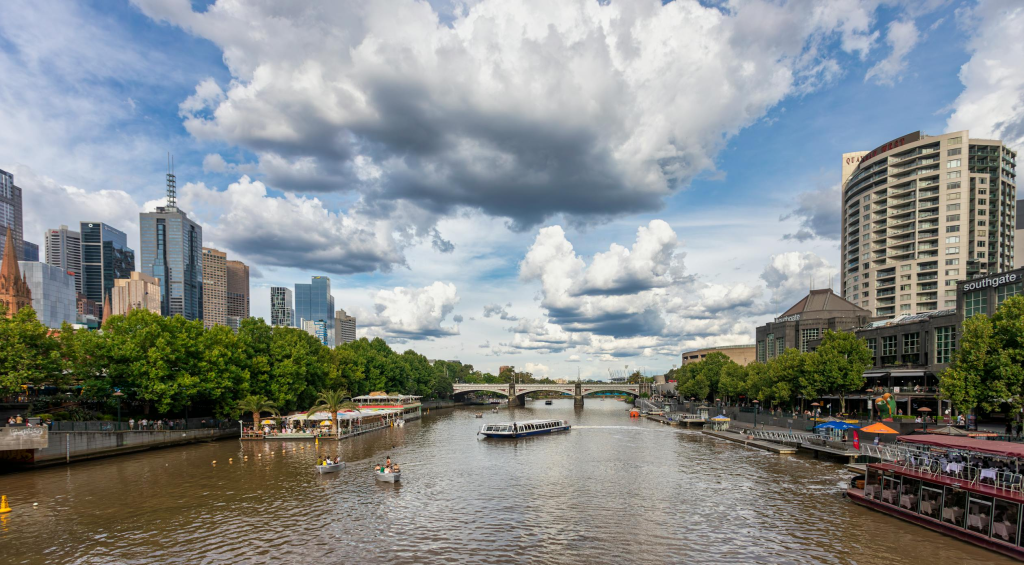
Nestled in the southeastern part of Australia, Melbourne offers something for everyone, from lush parks and gardens to historic lanes filled with chic cafes and boutiques.
If you’re planning a visit to this cosmopolitan city, one of the most important factors to consider is timing.
In this guide, we will explore the best months to visit Melbourne, what makes each season unique, and tips on how to make the most out of your trip.
The best time to visit melbourne largely depends on what kind of experience you’re after.
However, the consensus among travellers is that the best months to visit are from March to May (autumn) or September to November (spring). Both these periods offer pleasant weather, fewer crowds, and a rich cultural scene, making them perfect for exploring the city.
Autumn in Melbourne is a favourite among both locals and tourists. During this time, the weather is mild, with average temperatures ranging from 11°C to 20°C (52°F to 68°F).
The city’s parks, such as the Royal Botanic Gardens and Fitzroy Gardens, are at their most picturesque, with trees displaying stunning shades of orange, yellow, and red.
This period also coincides with major events such as the Melbourne International Comedy Festival in April, where comedians from around the world gather to deliver top-tier entertainment.
Additionally, sports enthusiasts can catch a game of Australian Rules Football (AFL), which is in full swing during these months.
For wine lovers, the Yarra Valley, a wine region just an hour’s drive from Melbourne, is perfect for day trips during autumn, as the grape harvest season brings wine festivals and tastings.
The temperate climate and abundance of events make autumn a prime time to visit Melbourne, particularly for those looking for a well-rounded cultural experience.
Spring is another popular season for visiting Melbourne, especially for nature lovers. Average temperatures range between 10°C and 19°C (50°F to 66°F), offering cool, comfortable weather perfect for outdoor activities.
The city comes alive with blooming flowers and popular spots like the Melbourne Zoo and the Royal Botanic Gardens are at their most vibrant.
One of the standout events during spring is the Melbourne Cup Carnival, held in early November. Known as “the race that stops a nation,” this horse racing event is one of the most significant social and sporting events in Australia, drawing crowds in their finest outfits.
Spring is also ideal for exploring Melbourne’s coastal regions. A trip along the Great Ocean Road is a must during this season, with scenic coastal views and wildlife spotting opportunities.
You’ll encounter fewer tourists compared to the peak summer season, allowing for a more relaxed experience.
Melbourne’s weather is known for its unpredictability. It’s common to experience all four seasons in a single day, so packing for a trip can be tricky.
Let’s break down the weather by season to give you a better idea of what to expect.
Summer in Melbourne can be quite hot, with average temperatures ranging from 14°C to 25°C (57°F to 77°F), though heatwaves can push temperatures into the high 30s (90°F).
This is the busiest time of year for tourists, as schools are on break, and many Australians flock to the city.
Beach lovers can enjoy the sun at St Kilda Beach or Brighton Beach, where colourful bathing boxes provide the perfect backdrop for photos.
The Australian Open, a major tennis event, also takes place in January, attracting sports fans from all over the world.
However, the downside to visiting Melbourne in summer is the large crowds and higher accommodation prices. It’s also worth noting that some days can be uncomfortably hot, which may limit outdoor activities.
If you’re visiting during this season, be sure to stay hydrated and seek shade during the hottest parts of the day.
Winter in Melbourne can be chilly, with temperatures ranging between 6°C and 14°C (43°F to 57°F). While this may not sound particularly cold compared to some other parts of the world, the wind chill can make it feel much colder.
The city also sees more rainfall during these months, so be sure to pack an umbrella and warm layers.
Despite the cooler weather, there’s still plenty to do in Melbourne during winter. The Melbourne International Film Festival takes place in August, showcasing films from around the world.
Additionally, winter is a great time to explore Melbourne’s famous laneways and street art without the hustle and bustle of peak tourist season.
If you enjoy snow sports, Mount Buller and Falls Creek, located a few hours from the city, offer skiing and snowboarding opportunities.
While it’s not the best season for outdoor sightseeing, winter in Melbourne has its charm, particularly for those who enjoy cozy indoor activities like visiting museums, galleries, and cafes.
Melbourne is a city full of unique attractions, from its vibrant street art to its bustling food scene. Here are some of the top activities to consider during your visit.
One of Melbourne’s most iconic features is its laneways, filled with street art, quirky cafes, and boutique shops.
Hosier Lane is the most famous of these, known for its constantly changing street art displays. Take a walk through the city’s hidden alleys to discover some of the best urban art in the world.
Located in the heart of Melbourne, Federation Square is a cultural precinct home to museums, galleries, and restaurants. It’s also a great spot to people-watch or attend one of the many events that take place there throughout the year.
Be sure to visit the Australian Centre for the Moving Image (ACMI), which celebrates Australia’s film and digital culture.
Take a Ride on the City Circle Tram
For a free and scenic way to get around the city, hop on the City Circle Tram.
This heritage tram takes you past many of Melbourne’s key attractions, including the Parliament House, Docklands, and Flinders Street Station. It’s a great way to get your bearings when you first arrive in the city.
Melbourne is a city that thrives on diversity and creativity, offering something unique for every traveller, regardless of the time of year.
While autumn and spring provide the most comfortable weather and a host of cultural events, summer’s vibrant atmosphere and lively festivals draw in those who crave sunshine and energy.
Even in the cooler months of winter, the city doesn’t lose its charm — instead, it offers cozy retreats in its countless cafes, art galleries, and theatres.
When planning your visit, consider not only the weather but also the type of experience you seek.
Do you want to stroll along the streets of Melbourne’s neighbourhoods, admiring the autumn leaves and sipping coffee from a quaint laneway café?
Or would you rather bask in the summer sun, exploring bustling markets and relaxing at the beach?
Each season has its rhythm, and Melbourne’s ever-changing landscape will reflect that.
Melbourne, a vibrant city renowned for its cultural diversity, architecture, and urban landscape, is home to several iconic structures, with its bridges playing a significant role in shaping the city’s connectivity and aesthetic charm.
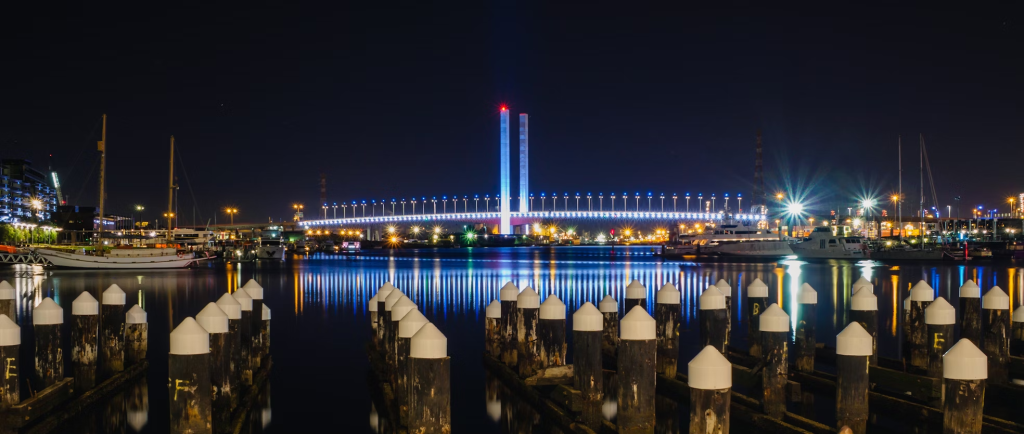
These bridges are more than just functional pathways for crossing water; they are symbols of engineering prowess and historical significance. Among them, one stands tall as the biggest and most recognised bridge in Melbourne, contributing to transportation and the city’s skyline.
In this article, we will delve into the history and details of the biggest bridge in Melbourne, explore other notable bridges that contribute to the city’s infrastructure, and discuss how these structures impact daily life and tourism.
The biggest bridge in Melbourne is the West Gate Bridge, a marvel of modern engineering and a crucial part of Melbourne’s road network.
Spanning the Yarra River and connecting the inner city to the western suburbs, this massive structure is not only the largest melbourne bridges but one of the longest bridges in Australia.
The West Gate Bridge is an enormous cable-stayed bridge that measures 2.6 kilometres in length and stands 58 meters above the Yarra River, offering stunning views of Melbourne’s cityscape and port.
The bridge has a dual function: it serves as a crucial route for vehicles travelling between the western suburbs and the city centre, while also acting as a symbol of Melbourne’s modern development.
It carries eight lanes of traffic and is a part of the M1 Freeway, one of the busiest roads in Australia, with approximately 200,000 vehicles crossing it daily.
The bridge’s design and construction were feats of engineering, although the project faced significant challenges during its development. Construction began in 1968, but a tragic collapse during construction in 1970 claimed the lives of 35 workers.
After rigorous redesign and safety enhancements, the bridge was completed and officially opened in 1978.
Since then, it has become a key piece of infrastructure, relieving congestion in other parts of the city and connecting the western suburbs more directly with Melbourne’s heart.
The West Gate Bridge has become more than just a transportation link; it holds a significant place in Melbourne’s history.
The tragedy during its construction led to improved safety standards in engineering projects across Australia, making it a symbol of the evolving approach to safety in large infrastructure undertakings.
In addition to its tragic history, the West Gate Bridge has become a prominent feature of Melbourne’s skyline.
It is visible from many points in the city and has inspired local art and culture, symbolizing the connection between Melbourne’s industrial and urban sides.
The bridge’s height and span offer an impressive view of Port Phillip Bay, making it a notable landmark for residents and tourists alike.
While the West Gate Bridge may be the biggest, Melbourne is home to several other iconic bridges that play key roles in the city’s connectivity and urban landscape. Here are two other notable bridges that contribute to the city’s identity:
The Bolte Bridge, named after former Victorian Premier Sir Henry Bolte, is another of Melbourne’s grand bridges. Opened in 1999, the bridge spans the Yarra River and Victoria Harbour, providing a vital link between the West Gate Freeway and the CityLink Tollway.
Its distinctive twin concrete towers, each 140 meters high, are an iconic feature of Melbourne’s skyline, easily recognizable and often photographed.
Although the Bolte Bridge is not as long or as high as the West Gate Bridge, it plays a vital role in the city’s traffic network.
Stretching over 5 kilometres including its approach ramps, the bridge serves as a key part of the CityLink system, which connects Melbourne’s western and northern suburbs to the city.
Unlike the West Gate Bridge, the Bolte Bridge does not have pedestrian access, as it is designed solely for vehicular traffic.
The architectural design of the Bolte Bridge is also noteworthy. Its sleek, minimalist lines and towering pylons give it a modern, industrial aesthetic that contrasts with the natural beauty of the Yarra River below.
At night, the bridge is illuminated, adding a touch of grandeur to Melbourne’s night skyline.
In contrast to the massive modern bridges like the West Gate and Bolte, the Princes Bridge offers a glimpse into Melbourne’s historical past.
Opened in 1888, this elegant structure crosses the Yarra River at the heart of the city, linking Flinders Street with St Kilda Road. The bridge is a key pedestrian and vehicular route, especially for those commuting from Melbourne’s southern suburbs into the CBD.
The Princes Bridge is a cultural icon, frequently featured in postcards and travel guides thanks to its proximity to Federation Square, the Arts Centre, and the picturesque views it offers of the Yarra River.
The design of the bridge is classic, with intricate ironwork and three large arches, giving it a distinct Victorian charm that contrasts with the more contemporary bridges found elsewhere in the city.
The bridge’s location and architecture make it a popular spot for tourists, who often stroll along its span to capture photos of Melbourne’s riverfront.
Additionally, it serves as a key part of the city’s public transport network, with trams regularly crossing over the bridge, further enhancing its importance in Melbourne’s daily life.
Bridges in Melbourne do more than just provide functional crossings over rivers and bays; they are integral to the city’s infrastructure and cultural landscape.
Each bridge, whether modern or historic, contributes to the daily lives of residents and the experience of visitors. Let’s explore how Melbourne’s bridges impact both transportation and tourism.
As a bustling metropolis, Melbourne relies heavily on its bridges to keep traffic flowing smoothly.
The West Gate Bridge, Bolte Bridge, and several other key spans form essential parts of the city’s freeway network, enabling efficient movement between the suburbs and the city centre.
Without these bridges, traffic congestion would significantly worsen, making it difficult for commuters to reach their destinations promptly.
These bridges are also crucial for the freight industry, connecting Melbourne’s ports with industrial areas and ensuring the smooth transport of goods across the region.
The West Gate Bridge, in particular, is vital for this purpose, as it provides a direct route to the Port of Melbourne, one of Australia’s busiest cargo ports.
Bridges in Melbourne also serve as tourist attractions in their own right. Visitors to the city often include a walk or drive over these iconic structures in their itinerary, particularly the Princes Bridge due to its location near several major landmarks.
The West Gate Bridge, while not as easily accessible for pedestrians, offers stunning views of the city and the bay, making it a popular spot for photographers and sightseers.
Additionally, Melbourne’s bridges have inspired a range of cultural works, from paintings to photography exhibitions.
The Bolte Bridge, with its sleek lines and towering pylons, is a particularly popular subject for photographers, especially when lit up at night.
Melbourne’s bridges, from the towering West Gate Bridge to the elegant Princes Bridge, are integral parts of the city’s identity, serving not only as crucial transportation links but also as cultural landmarks.
Each bridge tells a story of Melbourne’s growth, its engineering achievements, and its commitment to connecting its people.
Whether you’re a commuter, a tourist, or a resident, these bridges shape the way you experience the city, offering both practical utility and scenic beauty.
As Melbourne continues to evolve, its bridges will remain vital in ensuring the city’s vibrancy and accessibility for generations to come.
Melbourne, the capital of Victoria, is renowned for its vibrant culture, unique architecture, and world-class attractions. Often referred to as Australia’s cultural hub, Melbourne has been recognized globally as one of the world’s most livable cities for many years.

From its iconic laneways and thriving café scene to its stunning parks and sporting events, this city is a fascinating blend of history, diversity, and modernity.
Whether you are visiting for the first time or have lived here for years, Melbourne always finds a way to surprise and captivate you.
In this article, we will explore what makes Melbourne so interesting, why it’s a top destination for tourists and locals alike, and how it became such an iconic city in Australia.
Melbourne’s appeal lies in its multifaceted personality, where old-world charm meets modern innovation.
One of the most interesting aspects of Melbourne is its rich cultural diversity, which has shaped the city’s identity over the years.
The influx of immigrants from Europe, Asia, and the Middle East has enriched Melbourne’s food, art, and entertainment scenes, giving the city an international flavour.
The city’s laneways are a must-see, offering hidden gems that include street art, boutique cafés, and small galleries. Take a stroll down Hosier Lane, for example, and you’ll find vibrant murals and graffiti that turn urban walls into an outdoor art gallery.
These laneways are also home to some of Melbourne’s best restaurants, bars, and coffee shops, making them a focal point of the city’s thriving social life.
Melbourne is also known for its love of sports, with the Melbourne Cricket Ground (MCG) being one of the largest and most iconic sporting venues in the world.
The MCG hosts some of the biggest sporting events in Australia, including Australian Rules Football (AFL) games, international cricket matches, and the annual Boxing Day Test.
The city also celebrates its sporting prowess with the Australian Open tennis tournament, which draws crowds from around the globe each January.
What’s equally captivating about Melbourne is its emphasis on creativity and innovation. The city is home to several renowned universities and research institutions, making it a hub for education and technological development.
Its creative industries are booming, from fashion and design to film and television production, further contributing to Melbourne’s unique character.
Additionally, Melbourne’s festivals and events calendar is packed year-round, with events like the Melbourne International Comedy Festival, Melbourne Fringe, and the White Night Festival drawing thousands of visitors.
These events celebrate Melbourne’s love for the arts and offer a platform for local and international artists to showcase their talents.
There are many reasons why people fall in love with Melbourne. At the heart of it all is the city’s irresistible café culture, which has earned
Melbourne a reputation as a coffee lover’s paradise. The café scene is unlike anywhere else in the world, with baristas perfecting their craft to serve some of the best brews in cozy, atmospheric venues.
Whether you’re after a flat white, cappuccino, or long black, you’ll find yourself spoilt for choice in Melbourne’s coffee hotspots like Fitzroy, South Melbourne, and the CBD.
Melbourne’s art scene is another reason people are drawn to the city.
Home to the National Gallery of Victoria (NGV), the Australian Centre for the Moving Image (ACMI), and many independent galleries, Melbourne offers an endless stream of exhibitions, films, and cultural experiences.
The NGV International is particularly famous for its permanent collection of European, Asian, Oceanic, and American art, making it one of Australia’s leading art institutions.
The city’s architecture is a perfect blend of the old and the new, where heritage buildings stand tall beside modern skyscrapers.
Walking through Melbourne’s streets, you’ll notice how well-preserved Victorian-era structures like the Royal Exhibition Building coexist with contemporary landmarks such as Federation Square.
This mix of architectural styles makes Melbourne a photographer’s dream, as there’s something picturesque around every corner.
Melbourne’s love of live music also plays a huge role in its popularity.
The city has a long history of nurturing some of Australia’s most successful musicians, from rock bands to electronic artists. Venues like The Corner Hotel, The Forum, and the Palais Theatre are iconic stages where both local and international artists perform regularly.
With live gigs happening almost every night, it’s easy to see why music enthusiasts feel right at home in Melbourne.
Finally, Melbourne’s commitment to green spaces and the environment contributes significantly to its livability.
The city is home to several lush parks and gardens, such as the Royal Botanic Gardens and Fitzroy Gardens, which offer residents and visitors a peaceful retreat from the urban hustle and bustle.
The Yarra River, which winds through the city, provides scenic walking and cycling routes, allowing people to stay connected with nature even in the heart of the city.
Melbourne has no shortage of attractions, each offering a glimpse into what makes the city so special. Federation Square, located in the heart of the city, is one of the most visited public spaces.
Known for its distinctive architecture, Fed Square is a hub for cultural events, outdoor screenings, and art exhibitions. It’s also home to ACMI, where visitors can explore the history of film, television, and digital culture.
Another must-visit is Queen Victoria Market, a sprawling open-air market that’s been a part of Melbourne’s history for over 140 years.
Here, you’ll find everything from fresh produce and gourmet foods to clothing, jewellery, and crafts. It’s a great place to grab a bite to eat, do some shopping, or simply soak up the bustling atmosphere.
For those who enjoy nature, a visit to the Royal Botanic Gardens is essential. Spanning 38 hectares, these gardens offer a peaceful escape and feature a variety of plant species from around the world.
It’s a beautiful spot for a picnic, a leisurely walk, or even a guided tour to learn more about the flora.
If you’re into sports, you can’t miss the opportunity to tour the Melbourne Cricket Ground (MCG). The MCG is not only a sporting venue but also a historical landmark, with a museum that delves into Australia’s sports history, particularly cricket and AFL.
Art lovers should also explore the laneways of Melbourne, particularly Hosier Lane and ACDC Lane, where vibrant street art showcases the city’s creative spirit.
These laneways are a testament to Melbourne’s role as a leading force in street art, attracting artists from all over the world.
Finally, for panoramic views of the city, Eureka Skydeck offers breathtaking views from the 88th floor of the Eureka Tower.
It’s the highest public observation deck in the Southern Hemisphere and provides an unparalleled perspective of Melbourne’s skyline and beyond.
Melbourne is a city that continues to captivate visitors and residents with its dynamic blend of culture, art, and innovation.
From its iconic laneways and world-class coffee scene to its rich history and sporting traditions, there’s no shortage of reasons to explore Melbourne’s many layers.
The city’s diverse and inclusive atmosphere welcomes people from all walks of life, and its ever-evolving nature ensures there’s always something new to discover.
Whether you’re here for a short visit or a lifelong stay, Melbourne promises to leave a lasting impression.
In search of more information? Click and read this guide “summer nights drone show: docklands” today!
Perth, the sunniest city in Australia, comes alive during the summer months.
With pristine beaches, vibrant festivals, and long, golden days, summer in Perth offers a unique blend of natural beauty and outdoor activities that draw both locals and tourists alike.

Located on the west coast of Australia, Perth enjoys a Mediterranean climate, making it one of the best places to soak up the sun and explore the great outdoors.
This season brings not only warm weather but also a variety of experiences that highlight the city’s rich culture, diverse landscapes, and laid-back lifestyle.
In this article, we’ll explore what summer is like in Perth, what activities to enjoy, and how to make the most of your time in this sunny city during the hottest months of the year.
Summer in Perth runs from December to February, and it’s characterized by hot, dry weather and plenty of sunshine. Average temperatures range between 25°C to 35°C (77°F to 95°F), with some days reaching even higher peaks, especially in January.
Despite the heat, Perth’s coastal breeze, known as the “Fremantle Doctor,” offers a refreshing relief in the afternoons, making the summer days more manageable.
One of the defining features of summer in Perth is the dry heat. Unlike other parts of Australia that might experience tropical humidity, Perth’s summers are typically dry, which means less discomfort from sticky, humid air.
This type of heat makes the outdoors feel more bearable, as long as you stay hydrated and take breaks in the shade or indoors when necessary.
The sun shines for around 10 to 12 hours each day, offering ample opportunity for outdoor activities and sightseeing.
Perth is known for its clear blue skies, and it’s not uncommon to have long stretches of sunny days without a cloud in sight. For those seeking to escape colder climates, Perth’s summer offers the perfect setting for a warm-weather getaway.
With so much sunshine, it’s essential to prioritize sun protection. The UV index in Perth can be very high during the summer, increasing the risk of sunburn and skin damage.
Wearing sunscreen, hats, sunglasses, and light, protective clothing is crucial when spending extended time outdoors.
Many locals and tourists also take advantage of the early mornings and late afternoons when the sun is less intense to enjoy outdoor activities.
The evenings in Perth during summer are often cooler, with temperatures dropping to around 18°C to 20°C (64°F to 68°F).
This makes for perfect nights to dine al fresco, enjoy a sunset by the beach, or attend one of the many outdoor festivals and events that take place during this season.
The combination of warm days and cooler nights creates an inviting atmosphere for socializing and relaxing after a day of exploring the city or lounging by the ocean.
Perth’s sunny disposition and coastal location make it a haven for outdoor enthusiasts. From water sports to cultural festivals, there’s no shortage of things to do during the summer months.
One of the highlights of Perth’s summer is its beaches. With the Indian Ocean lapping at the city’s shores, locals and visitors flock to beaches like Cottesloe, Scarborough, and City Beach.
The soft white sand and crystal-clear waters make these beaches ideal for swimming, surfing, or simply soaking up the sun.
For those looking for a more relaxed experience, a picnic by the beach or a stroll along the shore during sunset can be just as rewarding.
Cottesloe Beach, in particular, is famous for its stunning perth sunset spots, where the sky turns a mixture of orange, pink, and purple as the sun dips below the horizon.
Beyond lounging on the beach, summer is the perfect time to dive into water sports. Surfing, snorkelling, and stand-up paddleboarding are popular activities along Perth’s coastline.
Rottnest Island, located just a short ferry ride from Perth, offers exceptional snorkelling spots with its coral reefs and abundant marine life. T
he island is also home to the adorable quokka, a small marsupial that has become an icon of Western Australia.
For those who enjoy more adrenaline-fueled activities, Perth’s Swan River provides opportunities for kayaking, jet-skiing, and sailing.
The river’s calm waters and picturesque surroundings make it a great spot for both beginners and seasoned water sports enthusiasts.
Summer in Perth isn’t just about outdoor adventure; it’s also a time when the city’s cultural scene thrives. The Perth Festival, one of Australia’s longest-running cultural festivals, typically takes place in February.
It features a diverse lineup of performances, art installations, and workshops that celebrate local and international talent.
The Fringe World Festival, another major event, brings comedy, theatre, music, and street performances to the city.
This vibrant festival is spread across various venues, including parks, theatres, and pop-up stages, offering something for everyone to enjoy.
Whether you’re a visitor or a local, making the most of Perth’s summer is all about balancing relaxation with exploration. Here are some tips on how to maximize your experience:
While the beaches are a significant draw during summer, Perth’s natural beauty extends far beyond the coastline. Kings Park and Botanic Garden, one of the largest inner-city parks in the world, offers breathtaking views of the city skyline and the Swan River.
During summer, the park is a great spot for picnics, outdoor yoga, and leisurely walks along its many trails.
For a more adventurous outing, head to the nearby Perth Hills. This region is known for its scenic hiking trails, stunning waterfalls, and charming wineries.
The cool shade of the forested areas provides a refreshing escape from the summer heat, and it’s a great place to enjoy the natural landscapes of Western Australia.
Summer is also the perfect time to indulge in Perth’s vibrant food and drink scene. The city is known for its fresh seafood, particularly its Western Rock Lobster, which is in peak season during summer.
Many restaurants along the coast offer seafood dishes that you can enjoy while taking in ocean views.
Perth’s summer is also synonymous with outdoor dining. Rooftop bars, beer gardens, and seaside cafes offer the ideal spots to enjoy a cool drink and delicious meal under the warm sun or starry sky.
Fremantle, a historic port city just south of Perth, is particularly famous for its lively markets, craft beer, and alfresco dining options.
In addition to cultural festivals, summer in Perth also brings a variety of outdoor markets, street fairs, and pop-up events.
The twilight markets in the city centre are popular for those looking to shop for local crafts, enjoy live music, and sample street food from around the world.
For bargain hunters, the Boxing Day sales in late December and the Australia Day celebrations in January offer the chance to score deals while taking part in the city’s festive atmosphere.
Summer is also a great time to explore Perth’s many weekend markets, where you can find fresh produce, handmade goods, and unique souvenirs.
Summer in Perth is a season filled with sunshine, outdoor adventures, and cultural festivities.
Whether you’re lounging on one of its pristine beaches, exploring the vibrant arts scene, or dining al fresco with friends and family, there’s something for everyone to enjoy.
The combination of hot, dry days and cool, breezy nights creates the perfect backdrop for making the most of this beautiful city.
From water sports to festivals, Perth’s summer provides countless opportunities to embrace the outdoors and experience the laid-back lifestyle that Western Australia is famous for.
So, grab your sunscreen, head to the beach, and enjoy all that Perth has to offer during its warmest, sunniest months.
Ut enim ad minim veniam, quis nostrud exercitation ullamco laboris nisi ut aliquip ex ea commodo consequat. Duis aute irure dolor in reprehenderit in voluptate velit esse cillum dolore eu fugiat nulla pariatur. Excepteur sint occaecat cupidatat non proident, sunt in culpa qui officia deserunt mollit anim id est laborum.

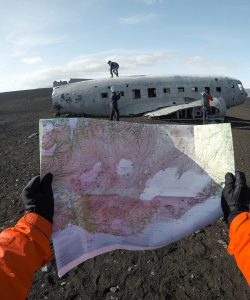




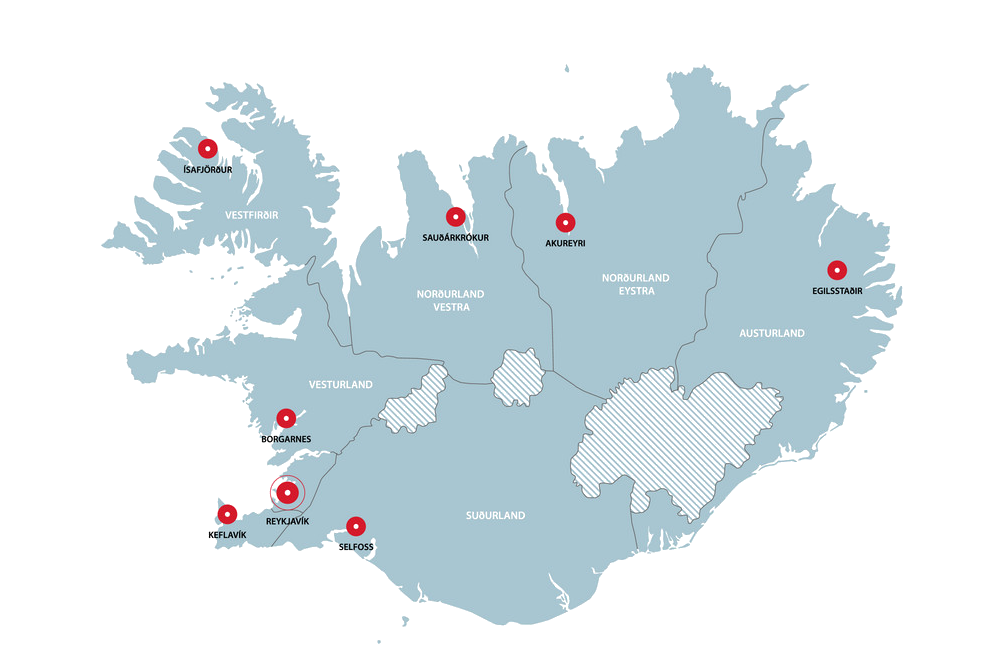
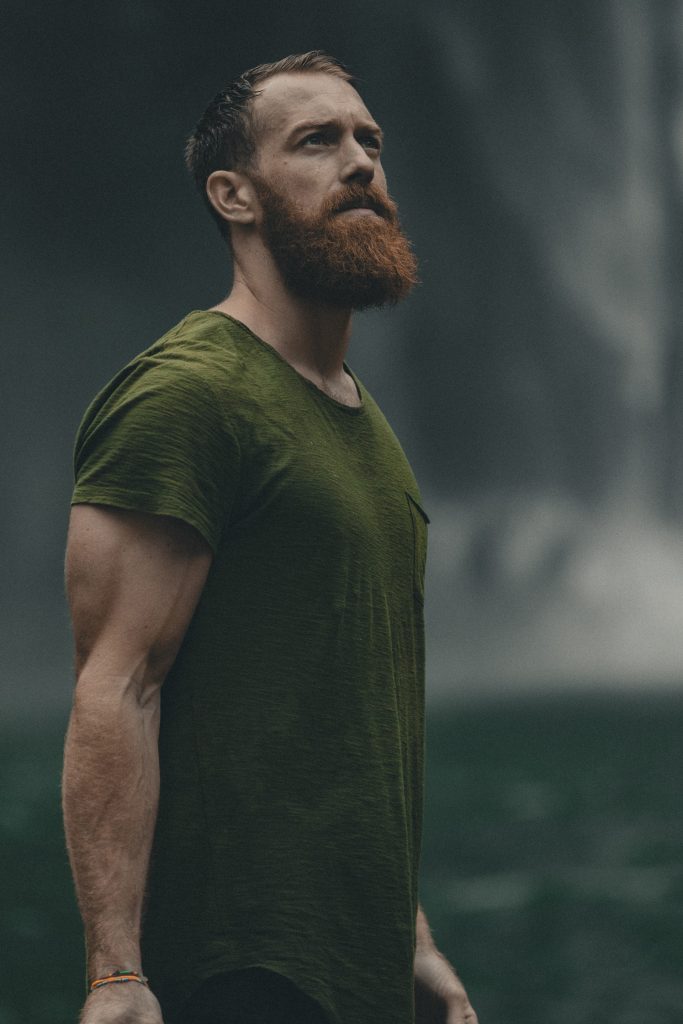
Minim veniam, quis nostrud exercitation ullamco laboris nisi ut aliquip ex ea commodo consequat. Duis aute irure dolor in reprehenderit in voluptate velit esse cillum dolore eu fugiat nulla pariatur. Excepteur sint occaecat cupidatat non proident, sunt in culpa qui.
